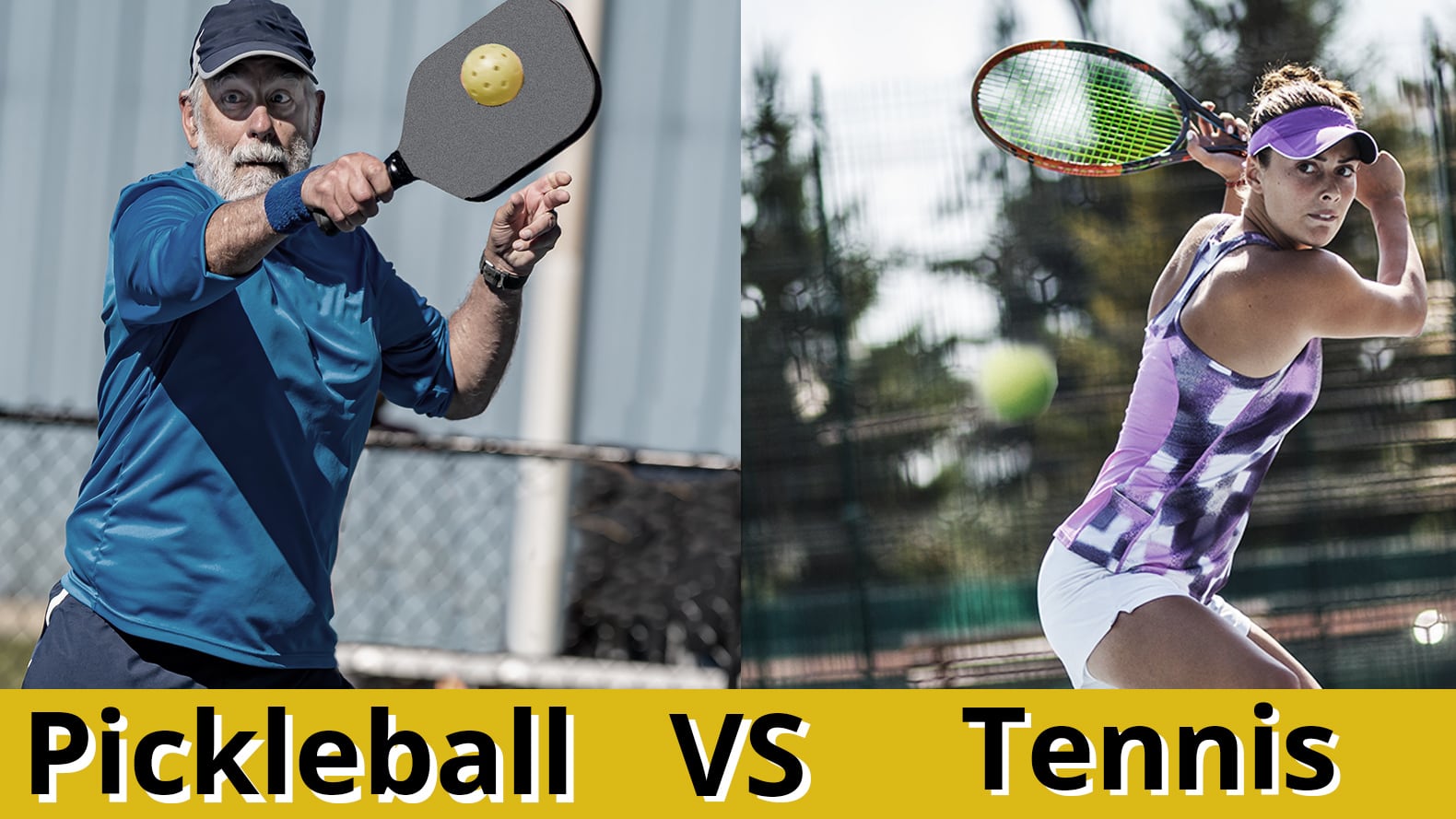It’s only natural to compare sports that have similarities, which is why so many people unfamiliar with pickleball will ask, “what’s the difference between pickleball and tennis?” Indeed, there are similarities but there are also differences. From the size of the courts and the nets to the type of surfaces of the paddles and rackets to the size and weight of the balls – there is plenty to discuss.
Pickleball is fast becoming one of the most popular sports in the U.S. and players in other countries are also taking great interest. We know there are plenty of questions that need to be answered for people to truly embrace the sport, so we’ve developed this guide to fill you in on the similarities between pickleball and tennis as well as the differences between the sports.
- Pickleball and tennis comparison
- What are the key differences between pickleball and tennis?
- The complete guide on how is pickleball different from tennis
- Pickleball court vs. tennis court
- What are the differences between pickleball and tennis equipment
- Pickleball net vs. tennis net
- Pickleball paddles vs. tennis rackets
- Pickleball balls vs. tennis balls
- How are the rules of pickleball different from tennis?
- How long does a pickleball game and tennis match last?
- The learning curve of pickleball and tennis
- What are the similarities between pickleball and tennis?
Pickleball and tennis comparison
Pickleball players often comment after their introduction to the sport that, “this is so similar to tennis, but also very different.” Pickleball and tennis have a lot in common, but the sport was not designed with tennis in mind, at least not solely.
Both sports involve players hitting a ball over a net, which can’t bounce more than once. The big difference is the power at which the balls are volleyed. Furthermore, pickleball is all about community, which is what makes it the top sport for the older generation. We’ll get into more of that later, but for now, let’s get a finer definition of pickleball and tennis.
What is pickleball?
If you’re an active person who has been on the hunt for a new recreation, perhaps you’ve heard of pickleball, but have wondered: What is pickleball? First and foremost, pickleball is considered a “paddle ball” sport due to the fact that it involves using a paddle, which is like an oversized table tennis paddle and is used to hit a ball similar to the one used in wiffle ball. It is considered one of the fastest-growing sports in America and has taken off around the world with citizens on nearly every continent playing. People of all ages and athletic ability can play it, from kids to seniors.
You can play doubles or singles, just like tennis, and you also have a net at center court separating opponents. To win a game of pickleball, the player or team has to be the first to win 11 points. A match is won by winning two out of three games.
What is tennis?
Most people are aware of tennis because it has been around far longer than pickleball. In fact, some say it got its origins in the 12th century in France where it was first played with the palm of the hand – rackets weren’t developed for another 400 years. Tennis is a popular sport throughout the world and has millions of fans who adore professional players but also enjoy getting on the court themselves as hobbyists.
The simplest way to answer “what is tennis?” is to say that it is a sport where players use a racket to hit the ball over a net and within a set of lines. A player gains a “point” when the ball cannot be properly returned. Women’s tennis has up to three sets and men’s tennis has up to seven sets. In either case, each set includes up to six games – the caveat being that the winner must win a set by two games, which means there could be a twelfth game or a tie-break. This is true for men’s and women’s tennis.

What are the key differences between pickleball and tennis?
Yes, pickleball and tennis have much in common, but there are some big differences. Both sports are incredibly fun and stimulating for the body and mind. There’s also a social aspect to each sport that brings people together and provides a sense of well-being. But each sport has a unique flavor of its own.
What even the most novice observers notice is that both sports involve a court, a net, a ball and either a racket or a paddle. With players hitting the ball over the net in an effort to outdo the opponent, it’s easy to see why the difference between pickleball and tennis is so often talked about.
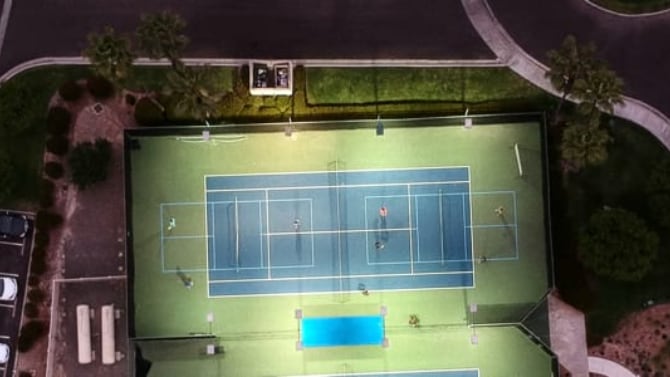
Here are major differences between pickleball and tennis:
Court size
A pickleball court is less than half the size of a tennis court. To be exact, a pickleball court is 20 feet by 44 feet. A tennis court is 36 feet by 78 feet.
Net height
While both sports have a net dividing each half of the court, a pickleball net is two inches shorter in height and 20 feet less in length.
Paddles and rackets
Pickleball players use paddles that are solid in the middle rather than having strings like a tennis racket. The paddles are also smaller than a tennis racket. Some paddles have air holes in them, while others are solid and smooth, lacking any texture.
Types of balls
Pickleball balls are made of plastic, which doesn’t bounce like a tennis ball. The tennis ball, which is covered in felt, is roughly 2.7 inches in diameter and weighs around 2.1 ounces. A pickleball has a smooth plastic exterior, is up to 3 inches in diameter, but is much lighter at .93 ounces.
Equipment cost
While professional equipment for pickleball and tennis can be exceedingly expensive for a modest recreation budget, both sports have plenty of equipment on the market that makes the cost of entry quite attractive, although pickleball gear is generally less expensive.
For example, A tennis ball can cost as little as $2.30, whereas low-cost pickleballs cost around 50 cents each. Tennis rackets can be found for less than $20 each, whereas low-cost options for paddles on Amazon cost $13 for two. Higher end equipment is also priced similarly.
How points are scored
In pickleball, the first player/team to score 11 points is the winner. In tennis, scoring is much different with zero points referred to as “love,” the first is called “15,” the second “30,” the third “40,” and the winner being the person who scores a point after 40. Essentially, the first player to win four points wins the game.
Furthermore, while pickleballs matches include the best of three games, tennis includes multiple games per set, with the winner of the most sets taking the match.
Serving rules
Both sports involve a player serving from a dedicated line with the ball having to land in a specific area of the court. But in tennis, an errant serve, called a “fault,” gets a redo. If the server in a pickleball game messes up their serve, they do not get a redo.
Kitchen/no-volley zone
There’s a kitchen in pickleball? Not in the traditional sense. The “kitchen” is a no-volley zone 7 feet from the net This is an area where the player cannot hit the ball unless it has hit the ground first. The “kitchen” terminology is borrowed from shuffleboard. Tennis does not include a no-volley zone.
Dinks/drop shots
The most common tactic in tennis is to hit hard and fast in an effort to hit past the opponent or to force the opponent to miss hit the ball. Such tactics are not as effective in pickleball, as the paddles aren’t made to generate that type of force. Also, the ball used in pickleball doesn’t have the same response as a tennis ball, making it even more difficult to power past the opponent. Therefore, pickleball players will rely on what’s called a dink or drop shot. A dink is hit from the kitchen line, whereas a drop shot is most often hit from the baseline.
Exertion levels
The pickleball court is much smaller than a tennis court. There is less area to cover, which means most pickleball players will exert less energy when playing the game as opposed to tennis. This is one of the reasons so many older adults segue from tennis to pickleball.
As you can see, there are plenty of similarities and differences between pickleball and tennis. In fact, many pickleball games occur on tennis courts that have been altered with shorter nets and temporary lines. If you’re already a tennis player and are about to jump into the pickleball world, you will not regret the decision.
The complete guide on how is pickleball different from tennis
How is pickleball different from tennis? There is plenty to cover with that question and we’ve got some fast answers for you here.
Pickleball court vs. tennis court
One of the more glaring differences between the pickleball court vs. tennis court debate is that the pickleball court is less than half the size of a tennis court. The pickleball court dimensions vs. tennis court dimensions make the smaller court quite attractive to those who are looking for a sport that requires covering less ground.
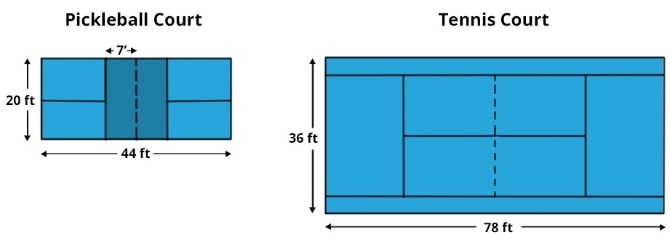
Tennis court dimensions
Tennis court dimensions for doubles matches are 36 feet by 78 feet. Tennis court measurements for singles matches are 27 feet by 78 feet. Tennis court size is far larger than pickleball courts.
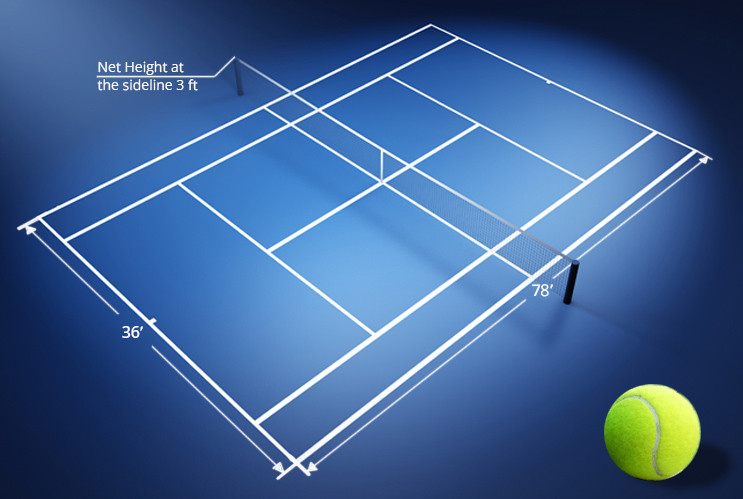
Pickleball court dimensions
Pickleball court dimensions are 20 feet by 44 feet, whether you’re playing singles or doubles. If you’re measuring diagonally, the pickleball court measurements should come out to 48 feet 4 inches. There is also the kitchen to account for, which is 7 feet deep on either side of the net. As you can see, the pickleball court size is far smaller than a tennis court.
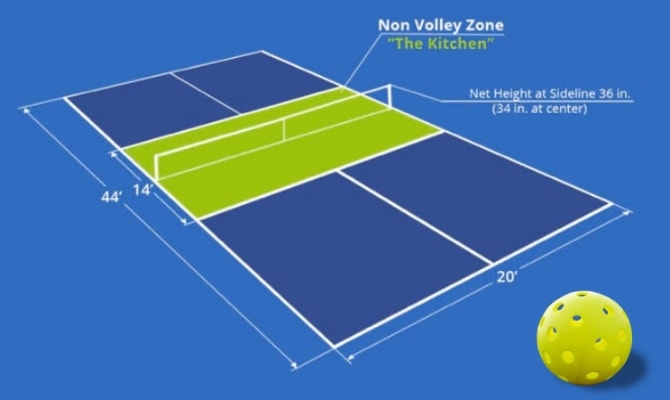
The difference between pickleball and tennis court size
The biggest difference between pickleball and tennis courts is that a pickleball court is smaller. If you’re transitioning from tennis to pickleball, you’re going to really feel the difference in the pickleball court size vs. the tennis court. However, if you are big into badminton, you’re not going to notice any difference, because the pickleball and badminton courts are the same size.
A pickleball court is much smaller than a tennis court.
Pickleball is a very social sport, which is why so many matches are doubles. So, when you get four players on that small of a court, it can seem quite cramped for longtime tennis players.
For example, in a game of doubles tennis, you have more than 2,800 square feet to work with. In pickleball, the square footage is only 880. The benefit here is that there is less ground to cover, so you don’t run yourself into exhaustion. But the downside is that it is easier to hit the ball outside of the lines in pickleball.
What are the differences between pickleball and tennis equipment?
Some of the big attractions to pickleball and tennis is that you only need a paddle or a racket and a ball and you are ready to hit your local court for some fun games. Compare that to golf where you need at least a dozen clubs, tees, balls, a glove, a golf bag, special golf shoes and whatever course rules require of your attire. Check out the following regarding the difference between tennis and pickleball equipment.
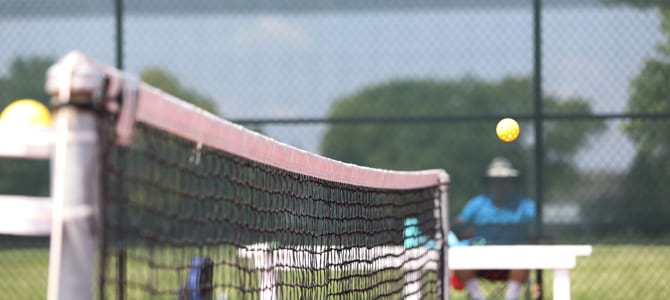
Pickleball net vs. tennis net
What is the height of a pickleball net and what is the height of a tennis net? In the following sections we’ll cover the pickleball net vs. tennis net discussion with everything you need to know about construction and the rules on size/height for each.
Tennis net height and other specifications
The tennis net height has been established by the International Tennis Federation (ITF), which means that regardless of which country you’re playing in, the nets should be the same. The rules state that the net must be 43 feet wide for doubles matches and 33 feet wide for singles matches. The nets are connected to posts, which must be 3.5 feet tall. In the middle of the net is a 2-in. strap. The tennis net height is 3 feet in the middle of the court.
You’ll notice on many public courts, the net will be set up for doubles, which is fine because singles matches can be played on doubles nets. For courts where there are singles and doubles nets, you’ll notice that the singles post is positioned 3 feet outside the single court lines. Doubles nets will include a post 3 feet outside the doubles line.
Tennis nets are made with either polyvinyl ethylene or polyvinyl chloride, which are fashioned into a mesh pattern. The holes in the mesh are small enough that a tennis ball cannot go through it. To keep the net taught, a metal cable is run through the top of the net and is connected to the side posts. All nets should be covered in a white band at the top and should be 2 to 2.5 inches wide.
Pickleball net height and other specifications
The USA Pickleball Association has established the pickleball net height at 30 in. from top to bottom in the middle and has a length of 21 feet 9 inches. The Association has also set other specifications, including court dimensions, which are 20 feet wide for doubles and singles matches. Also, the posts that support the net should span 22 feet. The pickleball net height should reach 36 inches at the posts, but be 34 inches off the ground in the middle. These rules apply to indoor and outdoor courts.
One of the similarities pickleball nets have with tennis is that they must have a 2-in. wide piece of tape over the metal cord that supports the net across the court. Also, to ensure the net is at the proper height in the middle, there is also a 2 in. vertical strap. Finally, the posts that support the pickleball net are to be 3 inches in diameter.
A pickleball net is slightly shorter than a tennis net.
Pickleball net compared to tennis – the similarities
While the length and height of a pickleball net and a tennis net are different, there are some similarities.
The following are some similarities between pickleball nets and tennis nets:
- In tennis singles matches, the second set of posts is used to support the net, and that post is 3 inches in diameter, which is the same as the posts used in pickleball.
- A cable runs through both nets, which supports it and keeps it at a constant height. The cable is hidden/covered by a two-inch band of white material
- If you don’t have a net made specifically for pickleball, you can use a tennis net as long as you adjust it to the specifications of a pickleball court.
- In order to maintain the regulated height of the net, each is strapped down at the center.
- Support posts for the net are set up outside the perimeter of the court in both sports.
- The nets are made of mesh using either polyvinyl ethylene or polyvinyl chloride. In both situations, the mesh is made small enough so the ball cannot go through it.

The difference between pickleball and tennis net
You’ll notice the court sizes between these two sports are dramatically different, but the pickleball net height vs. tennis net height is not that dissimilar. For example, the height is only two inches shorter in the middle for pickleball. At the posts, the net is four inches shorter in pickleball. For players using a tennis net, they must be able to make adjustments in order for it to be in regulation.
Another difference between an official pickleball net and a tennis net is that the pickleball net doesn’t need to be as long because the playing area is so much smaller. That means that a pickleball net only needs to span 21 feet 9 inches, compared to a tennis net, which is 42 feet wide.
The following are some differences between pickleball nets and tennis nets:
- The net used for tennis is sturdier and heavier because it needs to be able to handle the impact of the heavier and faster tennis ball.
- The pickleball net is two inches shorter in the middle than a tennis net.
- The mesh on a tennis net is smaller than a pickleball net, as the tennis ball is slightly smaller than a pickleball ball.
- The tennis court includes much more playing area, which requires a 42-foot net. The pickleball net only needs to span 21 feet 9 inches.
- The posts used for tennis nets must be sturdier than a pickleball net, as there is more weight and tension placed up on them.
Pickleball paddles vs. tennis rackets
While paddles and rackets are used to hit balls, they are quite different in several ways. The following information is everything you need to know about pickleball vs. tennis (paddles and rackets).
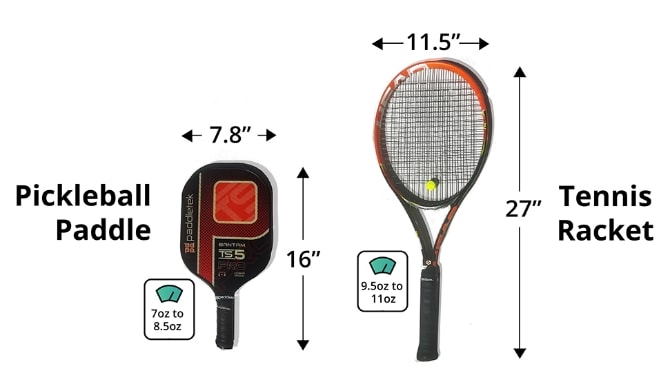
Tennis rackets
Ever wondered, “what are tennis rackets made of?” While early tennis rackets were made of wood, and then aluminum, the preferred material for today’s rackets is composite graphite. And while the graphite is quite light, the racket is heavier than a pickleball paddle. In fact, most rackets weigh around 10 to 11 ounces.
Pickleball paddles
What are pickleball paddles made of? Most pickleball paddles, which look like a cross between a tennis racket and a ping pong paddle, are made of composite materials, including graphite. Like the tennis racket, these too were made of wood in the early days. But given the lighter-weight materials used in modern paddles, they average around 7.5 ounces.
Pickleball paddles have a very different design to tennis rackets.
The difference between pickleball paddles and tennis rackets
First and foremost, you’ll notice a pickleball paddle is solid, whereas tennis rackets are strung with nylon or polyester strings. Tennis rackets are also heavier, on average, than pickleball paddles. You’ll also notice that the surface of the paddle has no texture to it. This makes it much more difficult, compared to tennis, for players to generate spin on the ball. And while the paddle is designed to make it more difficult, players can still generate spin when using the right techniques. You will also notice that pickleball paddles come in different thicknesses, which reflects the different playing styles and preferences.
The United States of America Pickleball Association’s rulebook says a paddle must not exceed 24 inches from the edge guard to the butt cap. Furthermore, the book states that the paddle must not exceed 17 inches in length on its hitting surface. As for weight and thickness, there are no rules.
For tennis players, they need to make sure their racket doesn’t exceed 29 inches in length. The stringed area of the racket must not exceed 15.5 inches in length and 11.5 inches in width.
For a quick recap, the major differences between paddles and rackets are:
- Size
- Surface
- Construction
Tennis racket handles are longer than the handle on a pickleball paddle. Two-handed backhand shots are common in tennis, but just because the handle on the paddle is shorter doesn’t mean pickleball players can’t also use two hands. However, most players employing this shot will put the index finger of their non-paddle hand on the face of the back of the paddle for added stability.
But what about the sound the balls make as they leave the surface of the racket or paddle? This is another big difference, because a tennis ball coming off a racket will make different sounds depending on the shot. A big serve might sound like a “whack,” whereas a topspin shot will have more of a “twang” sound as it comes off the strings. With pickleballs being made of plastic, they have a higher pitched sound, which can vary depending on the type of paddle being used, but is usually described as a “pop” or a “ping.”

Pickleball balls vs. tennis balls
Another big difference between tennis and pickleball is the type of ball used in each sport. The pickleball vs. tennis ball sounds are completely different, as are the materials used in their construction. Let’s take a deeper dive into each ball.

Tennis balls
The tennis ball size is actually smaller than a pickleball, coming in at a maximum of 2.7 inches. Tennis balls are almost always a fluorescent yellow (or “optic yellow”). Some training programs will start young tennis players out on blue balls and progress to other colors, including red, blue and orange. However, the official color is yellow, which is what you’ll see on most courts and in professional tournaments.
The tennis ball weight is between 1.98 and 2.1 ounces. As for speed, professional players hit serves at around 120 mph. Roger Federer, who won 20 grand slam tournaments, could serve the ball at 142 mph.
Pickleball balls
What type of ball is used in pickleball? Well, it’s far different from the ball used in tennis. Pickleballs are made with hard plastic. They’re hollow in the middle and have a variety of holes in them, similar to a wiffle ball.
The pickleball ball size is 2.92 inches in diameter, and while that is slightly larger than a tennis ball, it is far lighter, coming in at .78 to .93 ounces. All of these factors make the aerodynamic qualities of pickleballs different from tennis balls, which means they don’t travel as fast. Also, tennis balls tend to bounce much more when they hit the ground, which is not the case with pickleballs.
Finally, pickleball players will use a different type of ball when they’re outdoors. The outdoor balls have smaller holes, which helps aid against the wind impacting the flight of the ball.
A pickleball ball is larger and made of plastic.
The difference between pickleball and tennis balls
The pickleball vs. tennis ball size isn’t much of an argument in terms of diameter, as they are almost the same. However, the weight of the balls differs, as do the way they are constructed, the most obvious being that pickleballs are plastic and have holes in them.
In tennis, the balls are the same whether you’re playing inside or outside. With pickleballs being lighter and having holes in them, you’ll need a ball with smaller holes when playing outdoors. Also, these outdoor balls are made slightly heavier than indoor balls. These differences help to prevent the wind from being such a big factor.
How are the rules of pickleball different from tennis?
Initially, anyone new to pickleball will see that players seem to be following rules that are similar to tennis rules. However, official pickleball rules reveal some stark differences. Pickleball courts have a much smaller playing area, which means many of the balls are struck before they hit the ground. But the rules state that the ball must bounce off the ground on both sides of the court before it can be volleyed without bounces.
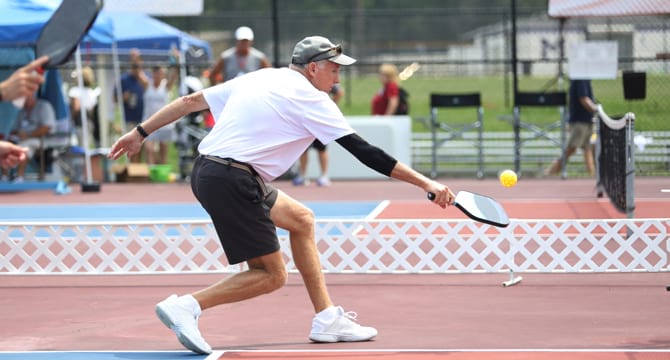
Pickleball scoring vs. tennis scoring rules
Pickleball scoring rules differ from tennis scoring rules. First and foremost, pickleball doesn’t have sets of games like tennis does. Rather there are only three games in a match. The winner in pickleball is the first to reach 11 points. Similar to table tennis (ping pong), you must win by two points, which means games can stretch beyond 11 points. Another difference is that you can only score in pickleball when you or your teammate is serving.
Pickleball serving vs. tennis serving rules
While serving is an integral part of the game for both sports, pickleball serving rules differ from tennis serving rules. There are also differences in technique. For example, most serves in tennis are overhand, while pickleball serves are underhand below the waist.
Similar to tennis, pickleball must go diagonally to the opposite side of the court and it must clear the kitchen area, which is seven feet of space beyond the net. However, most players will tell you it’s easier to serve the pickleball than a tennis ball, as the techniques are vastly different in skills required to hit the ball accurately. While tennis is often thought of as a power game where smashing the ball at top speed upon the serve is a revered talent, the opposite is true in pickleball where smashing a serve can make it too difficult and take the fun out of the sport.
Remember, when pickleball was invented, it was intended to be a sport that the entire family could enjoy, which is why it’s embraced by generations of players of all skill levels. And while the sport is quite competitive, it’s designed so anyone can play and have a good time, which is yet another reason why the serve in pickleball is not as intense of an experience as in tennis.
The pickleball Kitchen / No-Volley Zone
The pickleball no-volley zone is an area also referred to as the “kitchen.” This is a 7-foot area in front of the net where players are not allowed to volley, which means they can’t hit it straight out of the air. If the ball has bounced and it remains in the kitchen area, players can hit the ball back. The kitchen pickleball rule is meant to make the games more competitive and fun.
The kitchen’s no-volley zone keeps players from “playing the net” like one would in tennis. The reason for this is that the court being so much smaller than a tennis court, it would be too easy for a player to play the net and score against the opponent.
Pickleball rules about the kitchen are fairly straightforward, so if a player is coming from tennis where playing so close to the net can be a winning tactic, it’s easy to learn that the kitchen is an area they need to be conscious of as the ball is in play. Furthermore, coming to such a small court compared to tennis’s playing area, players will quickly see that the kitchen rule makes perfect sense.
Pickleball is mostly played at the kitchen line.
The Double Bounce rule
The pickleball double bounce refers to the ball hitting the court after being served, and then the second bounce is the ball hitting the court surface on the return. The rule states that these two bounces are mandatory before you can volley a ball out of the air.
Double-bounce tennis rules do not exist. Rather, a player must allow the serve to land in the designated area before returning it. The double bounce rule might seem confusing at first, but after you’ve played a few games, you’ll get it.
Pickleball was created using equipment from a variety of sports, so it is only natural that it shares similarities with them. Compared to tennis, most players will agree that it is easier to learn and to play. And while both sports can be played as singles or doubles, the courts are vastly different in size.

How long does a pickleball game and tennis match last?
How long does a pickleball game last? That all depends on the pace of play between competitors, but most matches, which are the best of three games, can be finished anywhere between 20 minutes to an hour.
How long is a tennis game? Tennis games are shorter, but there are six games in each set, so these matches average around 90 minutes.
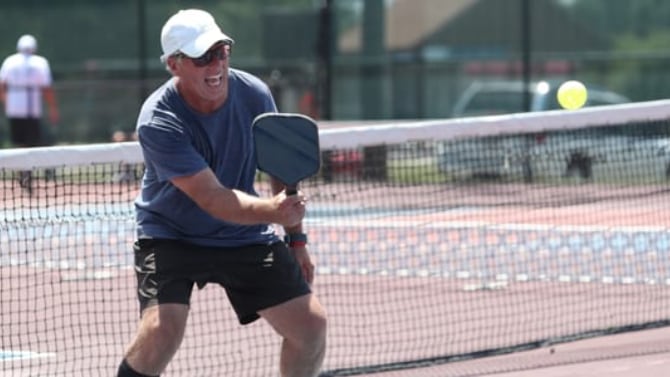
The learning curve of pickleball and tennis
Is it easy to learn to play pickleball? It’s a common question among newcomers and fortunately, the answer is a resounding yes. In fact, for those who learn to play tennis before coming to pickleball, they say tennis is more difficult to learn than pickleball. The concept of the game of pickleball is easy to grasp, but success on the court depends on the player’s athletic ability and willingness to work at getting better.
One of the reasons the learning curve is so much easier in pickleball is that the court dimensions are smaller, which means there is less physical strain involved compared to tennis. Also, take into account how much smaller the paddles are compared to the racket used in tennis – this makes hitting the sweet spot easier on a paddle. There’s a reason so many people only get really good at tennis after years of lessons and lots and lots of practice.
What are the similarities between pickleball and tennis?
There are some similarities between pickleball and tennis. We’ve covered the differences, so what about pickleball is similar to tennis? While you might see staunch defenders in either camp, some choosing one sport over the other, they have many traits that make them close cousins.
Singles or doubles
Singles and doubles matches are common in both sports. You’ll notice more similarities in singles than in doubles, but the concepts are similar. One of the biggest differences is that in pickleball doubles, there is no extra space used on the court like you’ll see with tennis doubles.
Techniques
Hand/eye coordination is important in both sports, as the technique of hitting the ball requires this skill. Also, you’ll see players in both sports take similar stances as they prepare to hit the ball, which includes keeping the legs spread, knees bent and using legs, hips and arms when hitting the ball.
Shots
Tennis rackets can generate more spin on the ball, but pickleball paddles can also generate some spin when it’s called for. The shots tennis players and pickleball players try to perfect include those with sidespin, backspin and topspin in an effort to shape a shot that makes it difficult for the opponent to return.
Indoor and outdoor courts
If you’ve ever watched professional tennis you’ll notice that the grand slam matches are played outdoors, but indoor courts are abundant for tennis enthusiasts at all levels. Pickleball players also enjoy playing on indoor and outdoor courts.
Net
There is only a two-inch difference in net heights. A pickleball net must be 34 inches high at the middle, compared to 36 inches for a tennis net.
Competitiveness
Followers of professional tennis know how intense matches can get, but if you’ve taken in pickleball tournaments, you’ll notice the same amount of intensity, as these sports bring out the competitive fire. And while matches can be intense, both sports are also played at a leisurely pace between friends where the intensity is far from what you’ll experience in a tournament.
Pick apart the differences and the similarities between tennis and pickleball and what you’re left with is that these sports have their merits and are justified in their popularity. While tennis is massive all over the world and is among the most played sports, pickleball is seeing a huge uptick in popularity with many tennis players converting to the pickleball court, as there are enough similarities for a smooth transition.
Pickleball versus tennis: Which sport is right for you?
Tennis has been around for so long that it has a huge fan base who watch professionals compete in televised tournaments across the globe, but there are also millions upon millions of people who enjoy playing the sport for fun. Pickleball is a relative newcomer, but it is gaining interest among sports enthusiasts throughout the world. In fact, the Sports & Fitness Industry Association says pickleball is the fastest-growing sport in America.
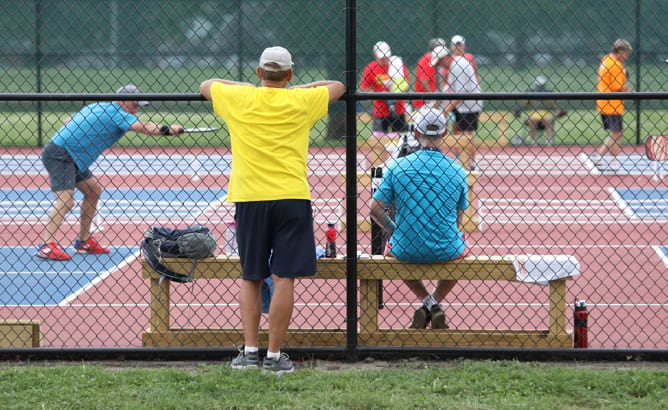
One of the greatest athletes of all time, NBA star LeBron James, helped to promote pickleball when he bought into the Major League Pickleball (MLP) in 2022. The MLP recently expanded from 12 to 16 teams and went from three to six major tournaments per year where the prize money has doubled to $2 million.
But in the “pickleball versus tennis” debate regarding which one is the best for you, that’s completely up to you. If you’re on a budget, you’re going to find the cost of entry with pickleball less expensive than tennis. If you’re looking for some physical activity but don’t have the stamina to cover a tennis court, you’re going to love the relative ease of the smaller pickleball court. If you don’t want to spend years and years on lessons to become proficient like you do with tennis, pickleball is going to be the sport for you.
Pickleball is an exceedingly social sport, too. For example, it’s difficult to get a crew of people, say family and/or friends, to join you in an afternoon of playing tennis. However, with pickleball, which is easy to learn and not as strenuous, you can involve a whole crew of people and have a blast.
One of the advantages of playing pickleball is that many players have developed a completely new social outlet simply by playing the game with people who were once strangers and are now friends. Part of being “healthy” involves a lot more than eating right and working out – it also includes socializing with others.
There is no reason people who are invested in getting a workout in and just enjoying themselves can’t embrace tennis and pickleball, but if you’re leaning toward pickleball, put our website in your bookmark bar and stay abreast of all the latest happenings with the sport.


